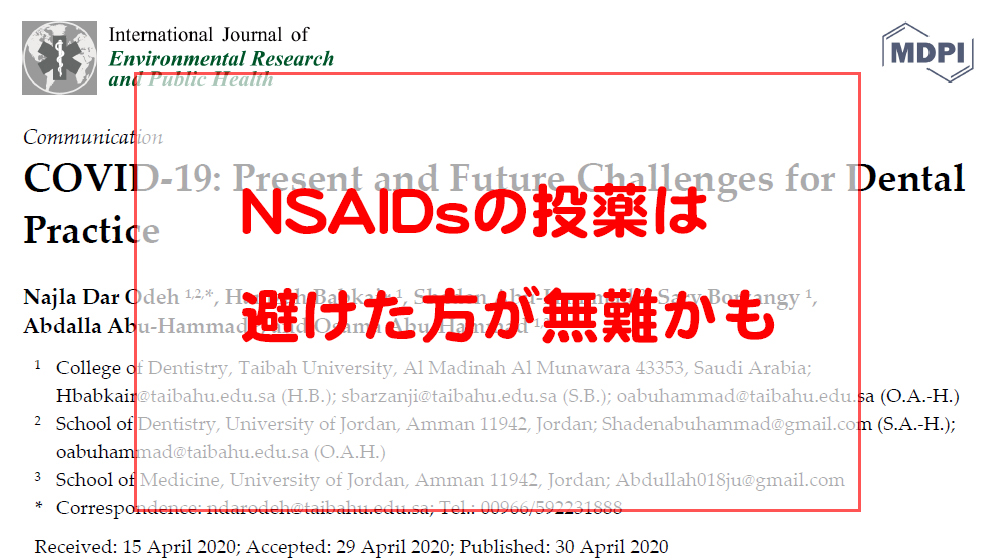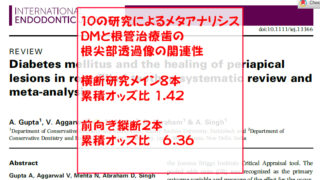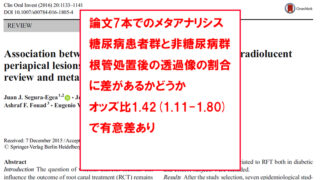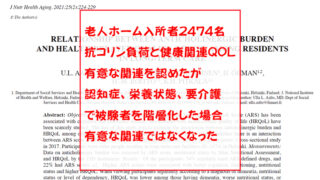COVID-19で歯科で考慮すること(鎮痛薬には注意)

サウジアラビアからの論文
さて、pubmedで COVID-19 dental で検索してボーッとみていたらあら?これ気になるな、という論文を見つけたので読んでみる事にしました。
サウジアラビアからで名前がAbu-Hammadの方が3人もいます。これはサウジでは多い名前なんですかね?
4/29にアクセプトされたばかりです。オープンアクセスのジャーナルなんですが、開設されて15年ぐらい経ってますし、IFも2以上あるのでまあ読んでみようかなと。どれだけ査読がしっかりしているかわかりませんが総説的な感じなので問題ないと判断しました。
COVID‐19: Present and Future Challenges for Dental Practice
Int J Environ Res Public Health. 2020 Apr 30;17(9). pii: E3151. doi: 10.3390/ijerph17093151.
PMID:32366034
https://www.ncbi.nlm.nih.gov/pubmed/32366034
いつもはアブストは全訳して後は適当に大事そうな所を要約していますが、実は今回はあまりアブストは重要ではなく一般的な事を書いてあって大事なのは文中にあります。よってアブストは訳しません。
忙しい方は薬剤の所だけ読んでください。それで足ります。しかし案外新型コロナウイルスについて知らないと思っている方はイントロダクションから読むとわかりやすいです。
Introduction
COVID‐19 was declared a pandemic by the World Health Organization (WHO), with substantial numbers of infected cases and deaths reported in many countries. Among these countries, Italy, the United Kingdom, and Spain had a high fatality rate ranging 4%–8% [1]. The disease is caused by one of the coronaviruses, which are a large family of viruses that may cause severe illnesses, such as Severe Acute Respiratory Syndrome (SARS) and Middle East Respiratory Syndrome (MERS). These viruses are common in animals with the potential of transmission to humans. They are composed of an envelope, a lipid layer, and single‐stranded large RNA. The name “corona” (“crown” in latin) is attributed to the spherical shape and surface projections. Four subfamilies have been identified: alpha‐, beta‐, gamma‐, and delta‐coronaviruses. Beta‐coronaviruses seem to originate from mammals, namely bats; it was found that the genome sequence of SARS‐CoV‐2, the virus responsible for COVID‐19, is >90% identical to a bat coronavirus RaTG13. In fact, bats represent a natural reservoir for a wide variety of coronaviruses including SARS‐CoV‐like and MERS‐CoV‐like viruses. SARS‐CoV‐2 is closely related to the SARS‐CoV virus, and it belongs to the B lineage of the betacoronaviruses, which are known to cause severe disease and fatalities.
COVID-19はWHOによりパンデミックであると宣言され、多くの国で感染者、死者が報告されています。イタリア、スペイン、イギリスなどは4~8%と高い死亡率となっています(注:今はもっと高いです)。この疾患はコロナウイルスの1種が原因です。コロナウイルスはSARSやMERSといった重篤な疾患を起こしています。これらのウイルスは動物には一般的で人に感染する可能性を有しています。このウイルスはエンベロープ、脂質二重層、巨大な一本鎖RNAで構成されています。コロナ(ラテン語でクラウン)と言う名前は球状の形態と表面の突起構造に起因しています。アルファ、ベータ、ガンマ、デルタの4種類のファミリーがあります。ベータコロナウイルスは哺乳類、即ちコウモリ、由来らしいです。これはSARS-CoV2のゲノム配列からわかりました。COVID-19の原因であるこのウイルスはコウモリのコロナウイルスRaTG13と90%以上同じ構造でした。この事実は、コウモリがSARS-CoVやMERS-CoVに似たウイルスを含む様々なコロナウイルスのリザーバーであることをしめしています。SARS-CoV2はSARS-CoVと非常に似ており、重篤な症状を起こすことで有名なベータコロナウイルスのB系統に属しています。
The origin of SARS‐CoV‐2 is still unclear, however, initial transmission from animals to humans has probably occurred in the Huanan seafood market in Wuhan, China in December 2019, where a cluster of pneumonia cases, caused by a newly identified β‐coronavirus, were diagnosed in this city.
The main clinical manifestations are respiratory in nature, and they manifest after a mean incubation period of five days (range: 0–24 days). An increased risk of infection was found in patients with certain co-morbidities mainly including hypertension, diabetes, and ischemic heart disease. A possible explanation for this association could relate to the nature of these diseases and the types of medications used for treatment. In hypertensive and diabetic patients, circulating amounts of angiotensin converting enzyme‐2 (ACE2) are increased. Moreover, some drugs including some types of antihypertensive drugs act as ACE inhibitors which further increase ACE2, and as SARS‐CoV‐2 binds to the host cell’s membrane via ACE2, an increased risk to infection is noticed [2].There is a wide variation between countries in the numbers of deaths and positive asymptomatic cases, with some reports indicating that approximately 80% of infected cases are asymptomatic [3]. Initial symptoms consist of fever, cough, nasal congestion, fatigue and other signs of upper respiratory tract infections. In approximately two thirds of the cases, the infection can progress to severe disease with dyspnea and severe lung congestion. Multi‐organ failure may eventually result in the form of respiratory failure, shock, acute respiratory distress syndrome, arrhythmia, acute myocardial injury, acute liver injury, and sepsis [4].
SARS-CoV2の起源は未だはっきりしません。しかし、2019年12月に武漢の華南海鮮市場にて最初の動物から人への感染が起こったと考えられています。最も多い臨床症状は呼吸器に発現します。潜伏期間は平均5日間(0-24日間)です。高血圧、糖尿病、心疾患などの基礎疾患がある人は感染リスクの増大が認められます。この関連は疾患とその服用薬によって説明できるかもしれません。高血圧、糖尿病の患者はACE2の循環量が増加しています。さらに、ACE阻害薬の中にはACE2をさらに増加させるものがあります。SARS-CoV2ばACE2を介して宿主細胞と結合するため、感染リスクが上がるのではないかと報告されています。国によって死者数や無症状の感染者の数はかなりのばらつきがあります。感染者の薬80%が無症状という報告があります。最初の症状は熱、咳、鼻症状、疲労感、その他上気道の感染徴候などです。(発症者の?)約2/3のケースで呼吸困難や深刻な肺うっ血などの可能性があります。呼吸器不全、ショック、急性呼吸窮迫症候群、不整脈、急性心筋障害、急性肝障害、敗血症という形で多臓器不全に至るかもしれません。
As of April 26, 2020, there have been more than 2.9 million cases, and more than 205,000 deaths globally. In response to this challenging pandemic, the Center for Disease Control and Prevention (CDC), American Dental association (ADA), the National Health Service (NHS), as well as other health regulatory bodies have provided advice to dentists to regulate dental services and to provide them with guidance in order to protect themselves, their co‐workers, and their patients from this infection.
Dentists are among the highest risk categories for transmission and contraction of the coronavirus, with many routine dental procedures having the potential to transmit the virus through aerosols. Asymptomatic (carrier) patients as well as patients with an acute respiratory illness may present for dental treatment at outpatient dental settings. While it is important to provide treatment for patients who present with urgent or emergency dental procedures, the primary goal should be to prevent transmission of infection to patients and dental healthcare personnel. The growing fear of cross‐infection, and the possible role of dental practice in spreading the infection, have obliged dentists to step aside and to confine themselves in home quarantine similar to other non‐healthcare sectors of the population. In addition, there has been an increased demand for personal protective equipment (PPE), which consists of garments to protect healthcare workers or any other persons to get infected. The standard PPE consist of gloves, mask, and gown. However, in case of airborne infections like COVID‐19, additional equipment should be utilized including face protection, goggles, mask, face shield, gloves, gown or coverall, head cover, and rubber boots [5].
多くの歯科治療手技はエアロゾルによる感染の可能性があるために、歯科医は感染、伝播リスクは最も高いと言えます。急性呼吸器疾患を有した無症状の感染者が患者として外来に来るかもしれません。緊急性のある歯科治療を提供することは重要ですが、主なゴールは患者や歯科医療従事者への感染を抑えることであるべきです。交叉感染の恐怖と歯科治療により感染が拡大する可能性により歯科医は他の非医療者達と同じように家に自分を隔離するようになりました。加えて、PPEの需要が拡大しています。スタンダードなPPEはグローブ、マスク、ガウンですが、COVID-19のような大気中での感染ではフェイスガード、ゴーグル、ヘッドカバー、ラバーブーツ等がさらに必要になります。
Dentists are now providing emergency dental procedures only, during which they have to follow the recommended cross‐infection control protocols. Therefore, the main bulk of published research directed to dentists has mainly focused on giving a background on the pandemic and what the recommended cross‐infection control measures are.
There are many aspects of COVID‐19 that are related to dental practice in addition to infection control, including prevention and treatment. There are also a number of clinical manifestations that affect the orofacial region and that dentists should be familiar with. This overview addresses the medical‐dental aspects of COVID‐19 infection. It is directed to dental healthcare personnel to update them on the recommended guidelines for provision of dental health services during this critical period, and to explain important aspects of the COVID‐19 infection with relevance to the orofacial region and oral healthcare. These aspects are divided into three sections: prevention, treatment, and oral manifestations.
歯科医は緊急の治療のみを現在行っています。そのため、現在パブリッシュされている歯科医向けの論文の多くが、パンデミックのバックグラウンドや交叉感染コントロールの指標は何か、といったものに焦点が当てられています。
感染コントロールに加えて歯科治療と関連するCOVID-19の様々な側面があります。歯科医がよく憶えておくべき口腔顔面領域に影響をあたえる臨床所見もあります。(一部略)この側面を3つのセクションに分けました。予防、治療、口腔症状の3つです。
Prevention: Provision of Dental Healthcare during the COVID-19 pandemic
The ADA has maintained a consistent stand since the pandemic was recognized. They called upon dentists to postpone elective dental procedures for all dental patients, and to provide dental treatment only for urgent or emergency cases [6]. The main aims were to minimize potential for healthcare transmission of COVID‐19, and to avoid shortage of PPE for healthcare personnel caring for those with COVID‐19, or dental healthcare personnel providing urgent dental care in emergency cases. They further clarified the meaning of dental emergencies as “potentially life‐threatening conditions that require immediate treatment to stop ongoing tissue bleeding, alleviate severe pain, or infection”; therefore, the emergency conditions indicated for treatment include cellulitis, uncontrolled bleeding, or trauma [7]. Within this context, provision of urgent dental treatment is to be done in regular dental clinics, and not to direct patients to emergency rooms even afterhours unless a life‐threatening emergency is encountered. Types of urgent dental care was lso clarified in detail to include: severe dental pain; certain infections such as pericoronitis, postoperative osteitis, dry socket, or abscess/cellulitis; trauma such as symptomatic fractured tooth or avulsion/luxation; as well s certain urgent restorative procedures [7].
The NHS, on the other hand, has initially provided advice to dentists to perform routine dental care only for patients with no symptoms of COVID‐19, provided that no aerosol‐generating procedures are undertaken. Recommendations of the NHS were updated according to the evolving situation of the pandemic so that the most recent recommendation was in concordance with that of the ADA.
パンデミックが認識されてきたADAは首尾一貫した態度をとっています。治療の延期と緊急時のみの対応です。これは医療従事者への感染を防ぐということとPPEの不足を避けるというのが主な目的です。さらにADAは緊急時の対応というものを命にかかわる可能性がありすぐに治療が必要な出血や激しい痛みを和らげるものと定義しました。そのため、緊急時というのは蜂窩織炎やコントロールできない出血、外傷などが含まれます。緊急時の歯科治療の規定として普通のクリニックで行われるものであり、命に係わる危機に遭遇しなければ時間外でさえ患者を救急処置室には誘導しないということになります。救急時の歯科治療とは以下のようなものと明確化されています。深刻な歯の痛み、智歯周囲炎や術後骨炎、ドライソケット、膿瘍、蜂窩織炎、歯の破折、脱臼などの外傷、緊急時の保存処置が必要なものなどです。
一方でNHSは当初はCOVID-19の症状がない患者のみに、エアロゾルが発生しない配慮をした上でなら通常の歯科治療をしてもよいと歯科医達にアドバイスをしていました。パンデミックという状態になってからはNHSもADAと同じ推奨にアップデートされました。
Treatment: Dental Aspects of Drugs Used for COVID‐19 Treatment
So far no definitive treatment is adopted for COVID‐19. A number of antiviral drugs as well as other drug categories were used so far with variable success rates. Some of these drugs have direct relevance to dental practice including analgesics, hydroxychloroquine, and azithromycin.
今の所、COVID-19の治療法として確立したものはありません。色々な薬剤が試されています。歯科治療と直接的に関係がある薬剤として鎮痛薬、ヒドロキシクロロキン、アジスロマイシンがあります。
Azithromycin
Azithromycin is a macrolide antibiotic that is particularly important in dental practice. It is a recommended antibiotic in the empiric treatment of odontogenic infections mainly in penicillinallergic patients [8]. It is also among the top five antibiotics prescribed in the dental setting in some countries including the USA, Brazil, and Belgium [9–11]. The long half‐life of azithromycin make it a favorable antibiotic for children who lack compliance and for whom a once daily oral dosage is recommended. Further, it is effective in the management of respiratory infections in young children[12].
Hospitalized patients usually receive the intravenous form of the drug for the treatment of community‐acquired pneumonia. This antibiotic is considered relatively safe in adults, children, and pregnant women [13]. However, a number of side effects have been identified especially with intravenous administration, which may be associated with gastrointestinal disturbances, ototoxicity, and pain and inflammation of the injection site [14] The development of resistant bacteria, [15] and its association with proarrhythmic events [16] have also been reported. The latter risk has been attributed to QT prolongation (summation of action potential of ventricular myocytes) , which can lead to a life‐threatening arrhythmia; however, susceptible patients usually have other co‐factors such as old age, heart disease, and exposure to other QT prolonging drugs [17].
In vitro studies have shown that azithromycin is active against Zika and Ebola viruses, [18–20] and is able to prevent severe respiratory tract infections when administrated to patients suffering viral infection [12] However, the efficacy of azithromycin in combination with hydroxychloroquine in the treatment of COVID‐19 patients has not been confirmed yet [21,22], and more studies are needed to further investigate its clinical effects. In light of the current shift of dental services towards the provision of emergency treatment only, and the possible increase in antibiotic prescriptions for severe orofacial infections, the use of azithromycin in dentistry should be monitored, especially that its use in dental practice as a favorable antibiotic is reported in countries with a high toll of COVID-19 infections. Alternative antibiotics such as amoxicillin or clindamycin (in penicillin‐allergic patients) should be considered for indicated cases, provided that no contraindications are present. An important example is patients who has a history of pseudomembranous colitis or ulcerative colitis, and hence cannot use clindamycin [23]. Dentists and physicians working in the treatment of emergency dental cases should be vigilant in prescribing antibiotics only for indicated cases and should consider the use of analgesic alternatives to control dental pain. Avoiding the development of side effects and antibiotic resistance should be considered among the goals of treatment.
アジスロマイシンはマクロライド系抗菌薬であり、歯科治療では特に重要です。主にペニシリンアレルギー患者の歯性感染治療で推奨される抗菌薬です。アメリカ、ブラジル、ベルギーなどの国々では歯科で使用される抗菌薬のトップ5に入ります。アジスロマイシンの長い半減期は服薬コンプライアンスがない子供や1日1回の服薬が推奨されるような人に向いています。さらに幼い子供の呼吸器感染症の管理にも効果的です。
院外感染性肺炎の治療の場合、入院患者は薬を静脈内投与されます。この抗菌薬は大人や子供、妊娠している女性に対しても比較的安全であると考えられています。しかし、静脈管理している際の副作用が認められます。消化管障害、耳毒性、針入部位の炎症痛などです。耐性菌の発生や不整脈誘発イベントへの関連も報告されています。後者のリスクはQT時間延長によるもので、生命に危険があるような不整脈を起こす可能性があります。しかし、そういった患者はすでに高齢、心臓疾患、QT時間延長を起こす薬剤服用等の要因を持っている事が一般的です。
In vitroでの研究ではアジスロマイシンはジカウイルスとエボラウイルスに対して活性を示しています。また、ウイルス感染で苦しむ患者の管理として呼吸器への深刻な感染を予防する事が出来ます。しかし、COVID-19においてはヒドロキシクロロキンとアジスロマイシン併用の効果はまだ認められていません。より臨床効果を検証する必要があります(注:実際に効果があったという論文が出ています Hydroxychloroquine and azithromycin as a treatment of COVID-19:
results of an open-label non-randomized clinical trial)。現在緊急時の歯科治療のみに制限されている状況で、深刻な口腔顔面領域の炎症に対して抗菌薬の使用は増加する可能性があります。歯科におけるアジスロマイシンの使用は監視されるべきです。特に歯科治療においてアジスロマイシンの使用が一般的でCOVID-19による死傷者数が多い国では。
アモキシシリンやクリンダマイシンの代用としてアジスロマイシンの使用は考慮されるべきです。重要例としては偽膜性大腸炎や潰瘍性大腸炎などの既往がある患者ではクリンダマイシンは使用できません。緊急時の歯科対応を行っている歯科医師は上記のようなケースでは抗菌薬の処方箋に注意し、疼痛コントロールのために鎮痛薬の使用を考慮すべきです。副作用と耐性菌の発生を避けるように考慮するべきです。
注:マクロライド系抗菌薬は日本は他国より処方量が多く、耐性菌の発生率がかなり高いと報告されています。http://www.jspid.jp/journal/full/02804/028040311.pdf
Chloroquine
Chloroquine is an antiparasitic drug that is primarily used as antimalarial drug since the 1930s. It has recently attracted a lot of attention due to its use in the treatment of COVID‐19. However, its use in the treatment of some oral diseases has been recognized for a long time. It was noticed to possess efficacy towards autoimmune diseases and has been implemented since the 1980s in the treatment of systemic lupus erythematosus (SLE), a disease that may have oral manifestations like ulcers. Its use in the treatment of primary Sjögrenʹs syndrome has been suggested by some scientists [24], and it is also recommended for the treatment of chronic ulcerative stomatitis [25]. It had been suggested for the treatment of oral squamous cell carcinoma due to its role in cell protection by eliminating excessive proteins and injured/aged organelles in the microenvironment of tumors with subsequent acceleration of tumor cell death [26].
The antiviral activity of the drug has long been recognized. In the current epidemic of COVID‐19 many countries announced its use in their trials to eradicate this disease. Scientists stated that the drug, which has established antiviral activity over the past 40 years, inhibited SARS‐CoV‐2 viral replication in vitro and human clinical application indicated apparent efficacy [27].
Hydroxychloroquine is a derivative of chloroquine with significantly higher solubility, and lower toxicity, therefore fewer side effects are anticipated [28].
Pharmacological modelling based on observed drug concentrations and in vitro drug testing suggest that prophylaxis with hydroxychloroquine at approved doses could prevent SARS‐CoV‐2 infection and ameliorate viral shedding [29]. The combination of antiviral drugs, such as remdesivir and chloroquine, has been considered highly effective in the control of infection in vitro and has been suggested in the treatment of Covid‐19 due to its safety profile [30]. However, clinical trials conducted so far are limited in sample size and their lack of randomization cast doubt on reported outcomes.
It is still unknown how this drug exerts its anti‐viral activity, but some researchers believe it can inhibit the development of an acidic media in endosomes that transport it from the cell membrane to cytoplasm. Alkaline media in endosomes is believed to prevent viral transfer to cytoplasm and can thus limit the replication of several viruses [31].The activity of the drug against autoimmune diseases, such as SLE, is believed to be due to its action to prevent production or release of IL‐6 and TNF‐ α, and due to its inhibitory action on autophagy [32]. This activity of hydroxychloroquine has been demonstrated in vitro against influenza and coronaviruses, however, clinically in humans and on animals the therapeutic activity was less successful.
The drug is generally safe, with poisoning being associated with the dangerous side‐effects of retinopathy and immunosuppression [33]. However, it is contraindicated in pregnancy. During the current pandemic of COVID‐19, and due to increased demand, severe shortages of the drug were reported and adversely affecting on the regular autoimmune disease patients with countries banning its export. Dentists have to be aware that shortages of chloroquine may influence their patients who are dependent on this drug especially SLE and Sjogren’s syndrome patients who have oral manifestations. They also should be aware of the possible oral complications caused by the drug, namely melanotic pigmentation of the oral mucosa [34] and lichenoid reaction [35].
クロロキンは抗寄生虫薬であり、1930年代からマラリア治療薬として使用されています。COVID-19の治療における使用が注目を浴びてきています。しかし、いくつかの口腔疾患の治療に対しての使用も長い間認識されてきました。また、自己免疫疾患への効果を有し、1980年代からSLEの治療にも用いられています。SLEは口腔内に潰瘍を形成する事があります。初期のシェーグレン症候群の治療についても報告があります。慢性潰瘍性口内炎の治療薬としても推奨されています。口腔内の扁平上皮がんへの使用も提案されてきました。それはがん中の過剰蛋白と傷ついた、老いた細胞小器官を排除し、がん細胞の死を促進するという機序によります。
抗ウイルス性は長い間認識されてきました。COVID-19の流行において多くの国が試しに使用することを発表しました。科学者達は40年以上抗ウイルス効果が認められてきたこの薬はSARS-CoV2のウイルス複製を抑制し、人への臨床応用は効果的だろうと述べています。
ヒドロキシクロロキンはクロロキン化合物で溶解性が有意に高く、毒性が低く、副作用が少ないという特徴があります。in vitroではヒドロキシクロロキンの推奨量予防投与はSARS-CoV2感染を予防し、ウイルス排出を改善する可能性が示唆されています。抗ウイルス薬の複合投与、例えばレムデシビルとクロロキンは感染コントロールとCOVID-19の治療にかなり効果的と考えられています。しかし、臨床治験は今の所限られたサンプルサイズであり、ランダム化などが行われていません(注レムデシビルはエボラ出血熱の治療薬ではありますが、FDAは5/1にCOVID-19重症者に対する緊急時使用許可を与えました。許可の根拠となったのは、米国立アレルギー・感染症研究所(NIAID)主導で中等症から重症の患者を対象に行われた臨床第3相(P3)試験と、ギリアドが行っている重症患者対象のP3試験。NIAID主導の試験では、回復までの期間をプラセボに比べて31%早めることが示され(レムデシビル群11日、プラセボ群15日)、死亡率も有意差はつかなったものの改善傾向が示されました(レムデシビル群8.0%、プラセボ群11.6%))。
この薬がどのように抗ウイルス効果を発現しているのかはいまだ分かっていません。しかし、ある研究者達は細胞膜から細胞質への輸送をおこなうエンドソームの酸性媒体を抑制すると信じています。エンドソームのアルカリ性媒体はウイルスの細胞質への移動を抑制し、ウイルスの複製を制限すると信じられています。SLEなどの自己免疫疾患への効果はIL-6やTNF-αの産生と放出の防止とオートファジーの抑制によるものであると信じられています。ヒドロキシクロロキンのインフルエンザやコロナウイルスに対する効果はin vitroでは実証されていますが、ヒト、動物においてはあまり成功していません。
この薬は一般的には安全ですが、網膜症や免疫抑制といった重症な副作用に関連する毒性を有しています。また妊娠女性には禁忌です。COVID-19の流行によりクロロキンの不足が深刻になっている国があります。歯科医はクロロキンの不足がSLEやシェーグレン症候群のような口腔内に症状が起こり、この薬に依存する患者達が影響を受けるかもしれないことに注意するべきです。この薬の使用により口腔粘膜へのメラニンの色素沈着や苔癬様反応が認められる可能性があることにも注意するべきです。
Ibuprofen and NSAIDS in COVID‐19 Patients
Since the recognition of the COVID‐19 pandemic, professional regulatory bodies advised against provision of dental treatment except for emergency cases. It became essential that dental patients will rely on supportive therapy such as analgesics, and non‐steroidal anti‐inflammatory drugs (NSAIDs) for the control of dental symptoms of pain. Among these patients, some may be asymptomatic for COVID‐19. Furthermore, supportive analgesic, antipyretic therapy remains the backbone for the treatment of mild to moderate cases of COVID‐19. This may eventually lead to the increased demand on analgesics. There was a warning against the use of ibuprofen in the treatment of COVID‐19 due to the increased expression of angiotensin‐converting enzyme‐2, which is believed to be the binding receptor of the virus to the cells. Consequently, the accelerated expression of this protein would theoretically potentiate and enhance the infection.
This argument may be based on mechanistic or theoretical pharmacology rather than evidencebased clinical trials [36]. COVID‐19 can be such a severe infection in about 20% of the cases, forcing patients to choose ibuprofen as a more effective drug compared to paracetamol. Thus, the clinical manifestations potentially emanate from this fierce infection itself rather than the theoretical potentiating action of the drug. Further, there is no strong epidemiological evidence to suggest a harmful effect of ibuprofen on COVID‐19 patients [36].
The WHO recommendation in this case is to use paracetamol as first line treatment, while ibuprofen comes as second line treatment [37]. Recently, the National Institute for Health and Care Excellence (NICE) said that there is no evidence from published scientific studies to determine whether acute use of NSAIDs is related to increased risk of developing COVID‐19 or increased risk of a more severe illness [38]. This was confirmed by the NHS England in their recent commissioning policy for acute use of NSAIDs for people with or at risk of COVID‐19 [39].
Dentists should remain updated as more information emerges on the topic and should weigh any benefits against harm when prescribing analgesics for patients with dental pain. Paracetamol can be used as a first line analgesic, however, if it is not effective, they can prescribe ibuprofen or other NSAIDs unless there is a contraindication.
COVID-19のパンデミックが認識されてから、専門機関は緊急の場合以外の歯科治療は延期するようにアドバイスしてきました。歯科の患者の中には鎮痛薬やNSAIDSにより疼痛をコントロールしている人がいることは重要です。これらの患者の中にはCOVID-19の無症状感染者がいるかもしれません。さらに、中等度から重症なCOVID-19患者への基本的な治療として除痛、解熱があります。そのため、鎮痛薬の需要を増加させることになるかもしれません。ウイルスと細胞を繋げるACE2発現の増加によるCOVID-19の治療においてイブプロフェンの使用は注意です。
COVID-19は20%が重症化する可能性がありますが、アセトアミノフェンと比較してより効果が高い薬剤としてイブプロフェンの選択すると重症化する可能性があります。理論的に考えられる薬効よりも激しい感染を引き起こす可能性があります。しかし、COVID-19患者におけるイブプロフェンの害に関して明確なエビデンスはありません。
WHOはアセトアミノフェンを第1選択として使用するように推奨しています。イブプロフェンは第2選択です。最近ではNICEがNSAIDSの使用がCOVID-19重症化または他の重症疾患のリスクを増大させるエビデンスはないと発表しました。
痛みに対する対応として第1選択はアセトアミノフェンで、もしそれが効果が無い場合はイブプロフェンまたは他のNSAIDSを選択した方がよいです。
注:NSAIDSとCOVID-19感染症リスクの増大は以下のサイトもhttps://www.cancerit.jp/65020.html なども参考してください。しかし、明確なエビデンスは今現在はありません。
Oral Manifestations of COVID‐19
Salivary Gland Infection
The genome of COVID‐19 virus has been detected in saliva in the majority of patients with this disease [40], indicating the potential infection of salivary glands [41]. It is interesting to know that in some cases, COVID‐19 was only detected in saliva, with no evidence for its presence in the nasopharynx [42].
Positive salivary tests indicate possibility of transmission through the spread of saliva as respiratory viruses usually spread via direct contact or spatter and aerosol production from mouth and nose i.e. sneezing or coughing [41]. Furthermore, respiratory droplets containing influenza virus have been detected even during normal breathing [43].
Although it is possible to detect the virus in saliva with viral culture, this should be interpreted with caution since saliva may contain secretions that originate from the nasopharynx or the lungs through the action of cilia [41]. However, this can be ascertained by choosing the correct method of saliva collection; to collect saliva from a particular salivary gland (the parotid gland for example) rather than obtaining the sample directly from the mouth [44].
The detection of virus in saliva is being used for monitoring saliva virus load during serial viral load monitoring instead of nasopharyngeal or oropharyngeal sources to reduce patient discomfort and health hazards to the operator during successive sampling [41]. Conducting COVID‐19 tests on saliva is easier for the patient and operator and the process bears less risk of cross contamination.Specimens can be provided by asking the patient to spit into a sterile container, and the operator stands little chance of exposure with such a non‐invasive procedure [41]. Saliva collection is more comfortable for patients than venipuncture as well as being more cost‐effective with minimal required instruments [45].
This finding is of particular interest to dentists. The initial recommendation by the NHS was to provide treatment to all patients except those with symptoms of infection. Also, all dental treatment was allowed except procedures that are associated with aerosolization. However, it is established now that there is a proportion of asymptomatic patients who may transmit infection, and the presence of the virus in saliva means that even non‐aerosol producing dental procedures can be a source of infection. Another important aspect of this finding is that dentists who are engaged in tobacco cessation efforts should disseminate awareness among their smoker patients of the possibility of salivary virus transmission via social sharing of tobacco smoking instruments namely the electronic cigarettes and waterpipe [46].
多くのCOVID-19患者の唾液からウイルスのゲノムが見つかってます。これは唾液腺が感染している可能性を示唆しています。唾液からは検出されるのに鼻咽腔からは検出されないケースがあります。
気管のウイルスは普通は直接接触またはくしゃみや咳などによる飛沫、エアロゾルを介して拡散するので、唾液が陽性であるということは唾液を介した感染の可能性が示唆されます。さらに、インフルエンザウイルスを含んだ呼吸器系の飛沫は正常な呼気にさえ存在しています。
唾液からウイルスが発見されたとしても、それは鼻咽腔または肺から繊毛により運ばれてきたものかもしれません。唾液腺開口部から直接採取することにより唾液自体にウイルスが存在する事が確かめられました。
唾液採取によるウイルス同定は安全性や簡便性、快適性などで鼻咽腔などよりも優れています。
特に歯科医にとって興味深い発見です。NHSの当初の推奨は症状がない患者は治療して良いというものでした。エアロゾルが発生しない治療は全ての行ってよかったのです。しかし、唾液中にウイルスが存在すると言うことはエアロゾルが発生しない治療に関しても感染の危険性があるということです。他の重要な側面としては、電子たばこや水たばこと呼ばれるたばこの吸入器の共有を介して唾液による感染の可能性を禁煙に従事する歯科医師は喫煙者達に広めるべきです。
Taste Abnormalities
Loss of taste and smell have been recognized lately as one of the symptoms of COVID‐19 [47] An Italian team reported that 20 out of 59 COVID‐19 patients who were interviewed (33.9%) had at least one taste or olfactory disorder and 11 (18.6%) had both [47]. Most of the patients with these symptoms (91%) reported the occurrence of taste alterations before being hospitalized. Taste and smell disorder in this case could be explained by the fact that SARS‐CoV‐2 has been known for its interaction with angiotensin converting enzyme 2 (ACE2) receptor, to facilitate its penetration into the cell, and this receptor is widely expressed on the epithelial cells of oral mucosa and the brain [48]. In fact, expression of ACE2 was found to be higher in tongue, where the taste buds are most abundant, than gingiva or buccal mucosa. [48] Another possibility is that SARS‐CoV‐2 could also be detected in saliva and infection of salivary glands is also possible [40], which increases the availability of virus in the oral cavity and its uptake by the epithelial cells.
Dentists should be aware of this symptom since they may encounter patients with taste abnormalities in the form of dysgeusia or burning mouth syndrome. This is particularly important because these symptoms may precede the onset of respiratory diagnostic manifestations of the disease. However, reporting of this symptom should be interpreted with caution as the affected patients are known to be of the old age group who are already susceptible to taste and smell disorders.
味覚と嗅覚の消失はCOVID-19n徴候の1つとして最近認識されるようになりました。イタリアのチームは59症例中20例が味覚または嗅覚障害を、11例に両方を認めました。これらの症状を伴った多くの患者(91%)は入院前に味覚の変化が起こったと報告しています。味覚や嗅覚障害はSARS-CoV2ウイルスがACE2レセプターを介して細胞に侵入することで説明されます。ACE2レセプターは口腔粘膜や脳の上皮細胞に広範囲に発現しています。また、ACE2は味蕾が多く存在する舌に多く発現しています。他の可能性としてはSARS-CoV2が唾液からも検出され、唾液腺感染も可能性があり、それはウイルスの口腔内での活動性を増加させ上皮細胞に取り込まれやすくなる事も挙げられます。
歯科医は味覚障害や口腔内灼熱症候群で味覚異常に遭遇することがあるので、この症状には注意するべきです。COVID-19において呼吸器症状に先行して発生する可能性があるので非常に重要です。 しかし、すでに味覚や嗅覚障害を起こしている可能性のある高齢者には注意が必要です。
まとめ
投薬、特にNSAIDsの投薬はこの時期慎重になるべきかもしれません。
ただし、エビデンスはありませんし、実際エビデンス構築が行われれば影響はない、ということになるかもしれません。
当院も基本アセトアミノフェンです。アセトアミノフェンはあまり効かないと思っている方もいらっしゃるかもしれませんが、1日最大4000mgまで投薬できるようになりましたので、以前と比べると鎮痛効果はかなり高いです。痛みが想定される場合500mg2錠を1日3回当院では投薬することもそれほど多くは無いですがあります。
アジスロマイシンですが、日本では肺炎球菌の耐性率やマクロライド耐性マイコプラズマ肺炎などを考えると予防的にどんどん投薬したりするのはあまりやめておいた方がよいと思います。
アジスロマイシン単独でCOVID-19に効果があるかどうかに関しては論文が少しあるものの明確なエビデンスというものは今の所はないように感じました。全て目を通したわけではありません。
やはりクロロキンと併用されてこそなのかもしれませんね。アジスロマイシンとクロロキンはそれぞれ心臓に負担をかける可能性がありますので併用なら余計に注意が必要です。
味覚障害などの口腔関連症状に関しては以前読んだ以下のレビューと大体話は同じです。このレビューもかなり面白いので是非読んでみてください。
追記
NSAIDsとCOVID-19に関してもうちょっと調べてみた結果、今の所関係性を立証できるだけのエビデンスはありません。あくまで可能性という話です。かなり混乱して情報が錯綜拡大したという感じです。








